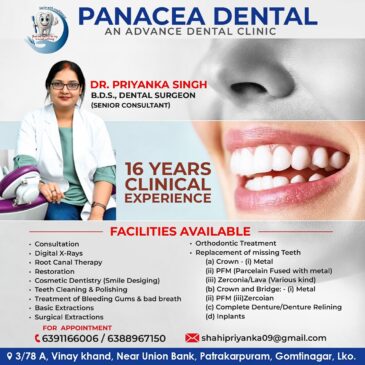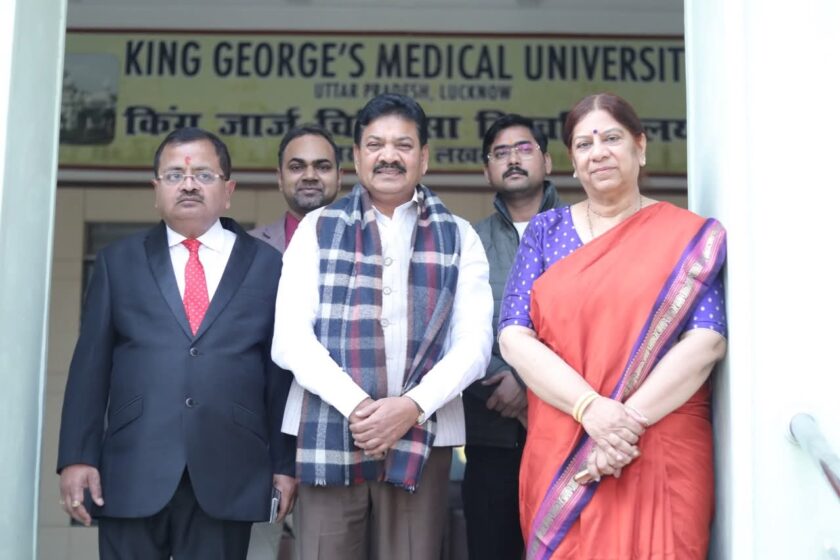Lucknow: The lungs are constantly exposed to environmental hazards, including toxic chemicals, particles and infectious agents that can damage the lungs in the air we breathe.
Worldwide, more than 2 billion people are exposed to harmful biomass smoke, often from indoor stoves or poorly ventilated fireplaces.

Additionally, 1 billion people face exposure to outdoor air pollution and tobacco smoke. The five leading causes of respiratory illness and death include asthma, chronic obstructive pulmonary disease (COPD), lung cancer, respiratory infections and tuberculosis (TB).
The burden of these diseases is highest in low- and middle-income countries, where it is exacerbated by the effects of smoking, air pollution and climate change.
Globally, more than 6.5 million people are affected by COPD, the third leading cause of death, and this number is rising.
Asthma is the most common chronic disease in children, affecting approximately 14 percent of children worldwide and its prevalence is increasing.
Tuberculosis remains the deadliest infectious disease, with more than 10 million cases and 1.4 million deaths annually. Lung cancer is the most common fatal cancer worldwide, with rates rising.
Pneumonia remains a leading cause of death and is the primary cause of death in children under five years of age.
Sleep apnea affects more than 100 million people, affecting up to 10 percent of adults in some populations. Occupational lung diseases affect more than 50 million individuals.
Pulmonary hypertension affects approximately 1 percent of the global population, with higher rates in those over 65. Pulmonary embolism, although under-reported, affects 6 to 20 per 100,000 people.
Air Pollution and the Lungs:
Air pollution is a major cause of respiratory diseases. It is responsible for 7 million deaths annually from COPD, lung cancer and respiratory infections.
Toxic air affects us all, from unborn babies to older people. Exposure to air pollution can reduce life expectancy, damage our lungs, worsen asthma and cause chronic respiratory diseases.
99% of the global population breathes air pollution above WHO guideline limits. Low and middle-income countries suffer the most from air pollution.
50% of the world’s population is exposed to household air pollution from open fires and wood-burning stoves, causing 1.5 million premature deaths each year.
“World Lung Day” is a dedicated global awareness event towards better lung health, celebrated globally on September 25 every year to highlight the most recent achievements in lung health.
The idea of World Lung Day (WLD) was first created during the 2016 FIRS Kyoto Assembly meeting organized by FIRS President Michiaki Mishima. The Forum of International Respiratory Societies (FIRS) is a federation of international respiratory societies collaborating to enhance lung health worldwide.
On this day, various local and international organizations join together to create awareness about the importance of healthy lungs by campaigning for lung health care globally. Also, the day commemorates the improvements made to prevent serious respiratory diseases.
The theme of World Lung Day this year is “Clean Air and Healthy Lungs for All”. The theme highlights the vital link between air quality and lung health. On World Lung Day, Indian Medical Association (IMA) – Medical Students Network, KGMU organised a Quiz Competition and CME on Lung Diseases. MBBS students participated in the Quiz Competition in which the first prize was bagged by Aakriti Mishra, second prize by Vaibhav Singh and third prize by Vaishnavi Jaiswal. Renowned experts Prof. (Dr.) Rajendra Prasad, Former Director Pulmonology Specialist, VPCI, New Delhi, Prof. Suryakant, Head, Department of Respiratory Medicine, Prof. (Dr.) J D Rawat, Department of Pediatric Surgery, Prof. Sarita Singh, Department of Anaesthesia and Prof. (Dr.) Ved Prakash, Head, Department of Pulmonary and Critical Care Medicine, KGMU discussed the overall health of lungs.
Common signs and symptoms of lung diseases:
1. Chronic cough – A cough lasting for more than 8 weeks may indicate lung problems such as chronic obstructive pulmonary disease (COPD), asthma, or a lung infection.
2. Shortness of breath (dyspnea) – Difficulty breathing or feeling of breathlessness, especially during physical activities, may be a sign of conditions such as asthma, COPD, or pulmonary fibrosis.
3. Wheezing – A loud whistling sound while breathing, often associated with narrowed airways, such as asthma, bronchitis, etc.
4. Chest pain – Discomfort or pain in the chest, especially while breathing or coughing, may be a sign of pneumonia or even lung cancer.
5. Frequent respiratory infections – Recurrent colds, bronchitis, or pneumonia may indicate underlying lung disease.
Blood in the mouth may indicate a lung condition, such as COPD or bronchiectasis.
6. Chronic mucus production – Excessive sputum (phlegm) production, especially when persistent or colored, may be a sign of infection or a chronic lung condition.
7. Fatigue – Feeling unusually tired or weak, especially during activity, may be associated with lung diseases that reduce oxygen supply to the body.
8. Bluish discoloration of the lips or fingertips (cyanosis) – A sign of low oxygen levels in the blood, cyanosis may indicate serious lung disease or heart problems.
9. Unintentional weight loss – Losing weight without trying, especially with other symptoms such as coughing and shortness of breath, may be a sign of serious conditions such as lung cancer or tuberculosis.
10. Coughing up blood – Bloody sputum may be a sign of serious lung diseases, including lung infections, chronic bronchitis or lung cancer.
Diagnosing Lung Diseases:
Medical history and physical examination: Diagnosis often begins with a complete medical history.
Pulmonary function tests (PFTs): These tests, including spirometry, measure lung capacity and airflow to evaluate conditions such as asthma, COPD, or pulmonary fibrosis.
Chest X-ray
Computed tomography (CT) scan
Blood tests: Blood tests measure oxygen and carbon dioxide levels or check for infections and autoimmune diseases affecting the lungs.
Bronchoscopy: A procedure using a flexible tube with a camera to examine the airways and collect tissue or mucus samples, useful in diagnosing lung cancer, infections, or bronchial diseases.

Sputum analysis: Examining mucus or phlegm from the lungs can help identify bacterial or fungal infections, as well as cancer cells.
Oximetry: This non-invasive test measures oxygen saturation in the blood, which provides information about lung function in conditions such as COPD or sleep apnea.
Treatment of Lung Diseases:
1. Medications:
ऽ Bronchodilators
ऽ Corticosteroids
ऽ Antibiotics/antivirals
2. Mucolytics
3. Oxygen therapy: Supplemental oxygen is provided for conditions such as COPD, pulmonary fibrosis, or major lung diseases where blood oxygen levels are low.
4. Pulmonary rehabilitation: A structured program that includes exercise training, education, and breathing techniques to improve the quality of life of people with chronic lung diseases such as COPD.
5. Lifestyle changes:
ऽ Quit smoking
ऽ Avoid triggers: Reducing exposure to allergens, pollutants, or occupational hazards can help prevent asthma and other lung diseases from worsening.
6. Surgery
ऽ Lung volume reduction surgery (LVRS)
ऽ Lung transplant: In cases of end-stage lung disease, lung transplant may be the only option to prolong life.
7. Vaccinations Vaccinations such as the flu and pneumococcal vaccines are important to prevent respiratory infections, especially in people with chronic lung diseases.
8. Ventilatory support
Non-invasive ventilation (NIV)
Mechanical ventilation
9. Antifibrotic drugs For diseases such as idiopathic pulmonary fibrosis (IPF), antifibrotic drugs help slow down the progression of lung lesions.
Prevention of lung diseases:
Lung diseases can be prevented by early detection and treatment of the underlying cause and practicing the following preventive measures and avoiding smoking
and avoiding exposure to air pollutants and certain chemicals
and avoiding second-hand smoke
and eating a healthy diet
and getting regular check-ups
and being physically active
and taking vaccines
The Department of Pulmonary and Critical Care Medicine at King George’s Medical University, Lucknow plays a vital role in providing world-class services in the field of pulmonary medicine, providing affordable care to the most vulnerable sections of society. The department has a 60-bedded facility equipped with a 30-bed state-of-the-art Respiratory ICU, an intervention suite, an advanced pulmonary function test lab, and a Level 1 polysomnography lab. It addresses the entire spectrum of lung diseases, ranging from infectious conditions to non-infectious diseases such as COPD, bronchial asthma, interstitial lung disease (ILD), and lung cancer including chemotherapy. The department is also proficient in performing both rigid and flexible bronchoscopies, offering advanced procedures such as debulking, stenting, and cryo biopsy. In addition, it provides comprehensive care to patients with obstructive sleep apnea and critically ill individuals. On the occasion of World Lung Day, the department organized a press conference to highlight its contribution to lung health and commitment to the community.
On the occasion of World Mesothelioma Awareness Day on 26 September 2024, Dr. Ved Prakash, Head of the Department of Pulmonary and Critical Care Medicine at KGMU, highlighted the urgent need for increased awareness and education about mesothelioma, a rare but aggressive cancer caused primarily by exposure to asbestos. Many individuals are unable to take any medication to prevent mesothelioma due to their risk factors.
Many people are unaware of the disease, as symptoms often mimic common respiratory conditions, leading to delayed diagnosis. Certain occupations are considered high-risk for mesothelioma due to potential asbestos exposure. These include:
Construction workers: Often exposed to asbestos in materials used for insulation, roofing and flooring.
Shipyard workers: Involved in shipbuilding or maintenance, where asbestos was commonly used for insulation.
Asbestos miners and millworkers: Direct exposure during the extraction and processing of asbestos.
Mechanics: Especially those working on older vehicles, which may contain asbestos in brake linings and gaskets.
Electricians: Exposure from old wiring insulation and other materials.
Plumbers and pipefitters: Working with asbestos insulation on pipes and boilers.
Firefighters: Likely to be exposed to asbestos in older buildings during firefighting activities.
Industrial workers: People working in factories that historically used asbestos in products such as insulation or building materials.
Laboratory workers: Handling materials that may contain asbestos in research settings
Dr Ved Prakash emphasises that early detection is key to improving patient outcomes and advocates for education on asbestos risks, regular health screenings and support for research initiatives.









